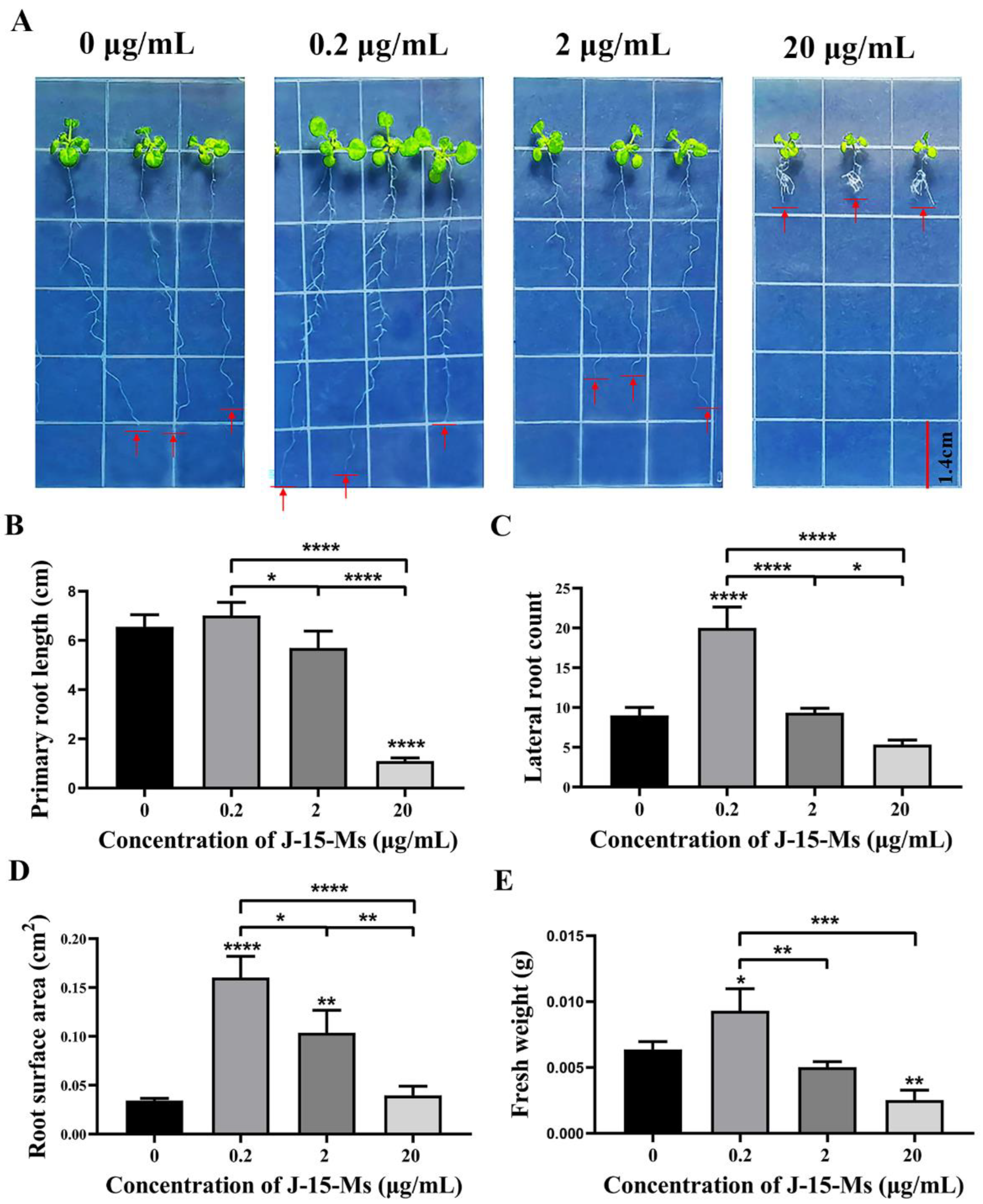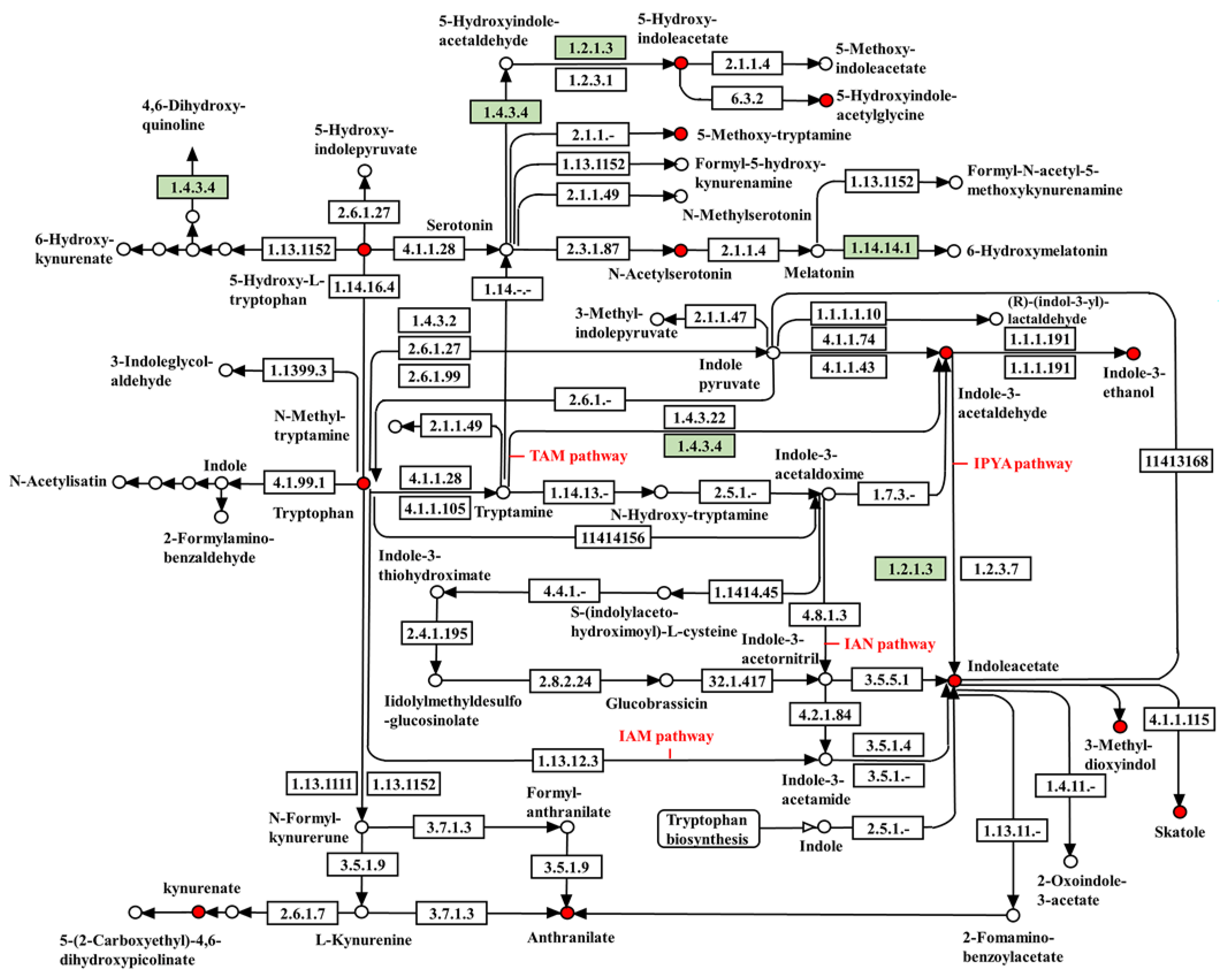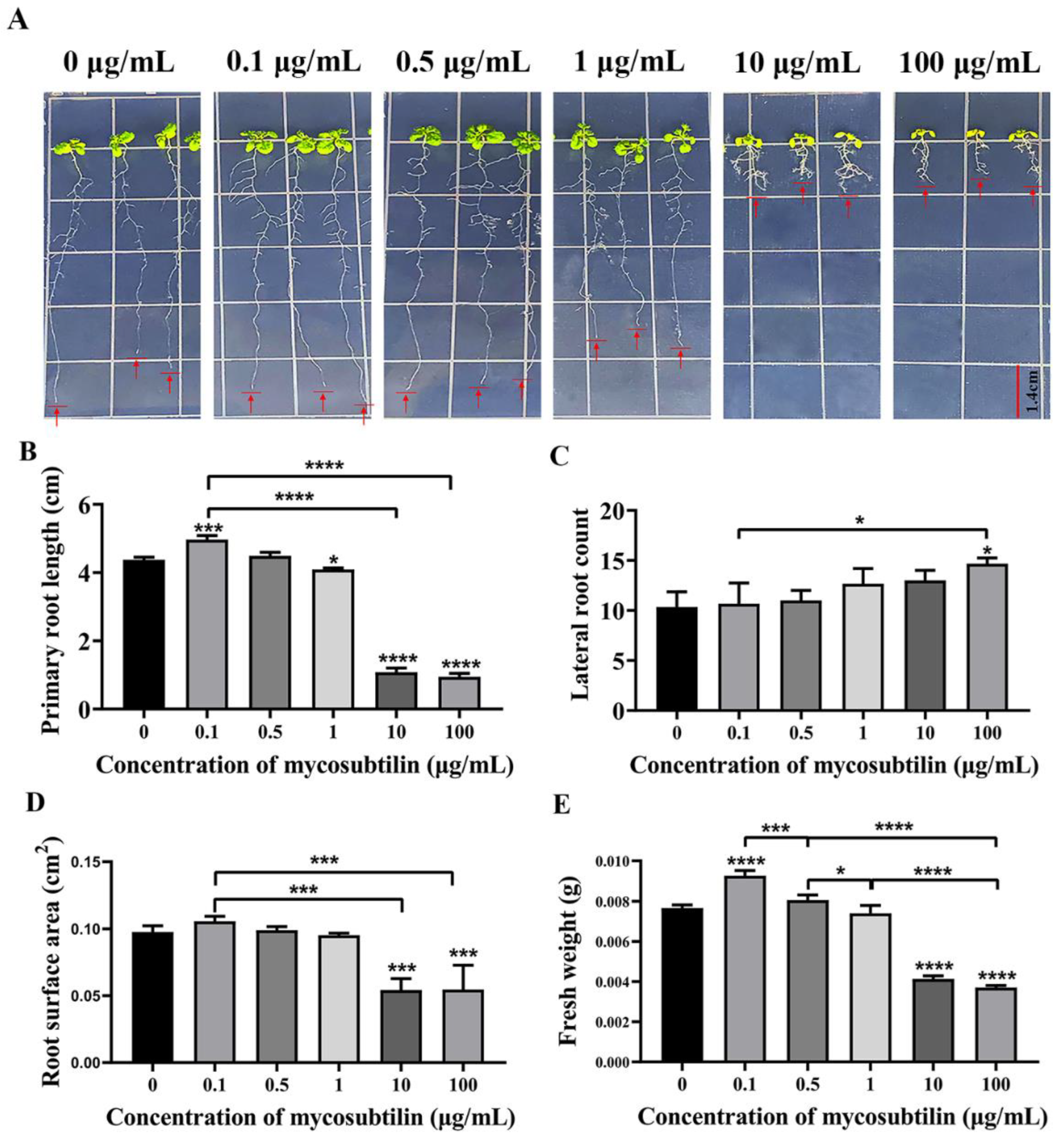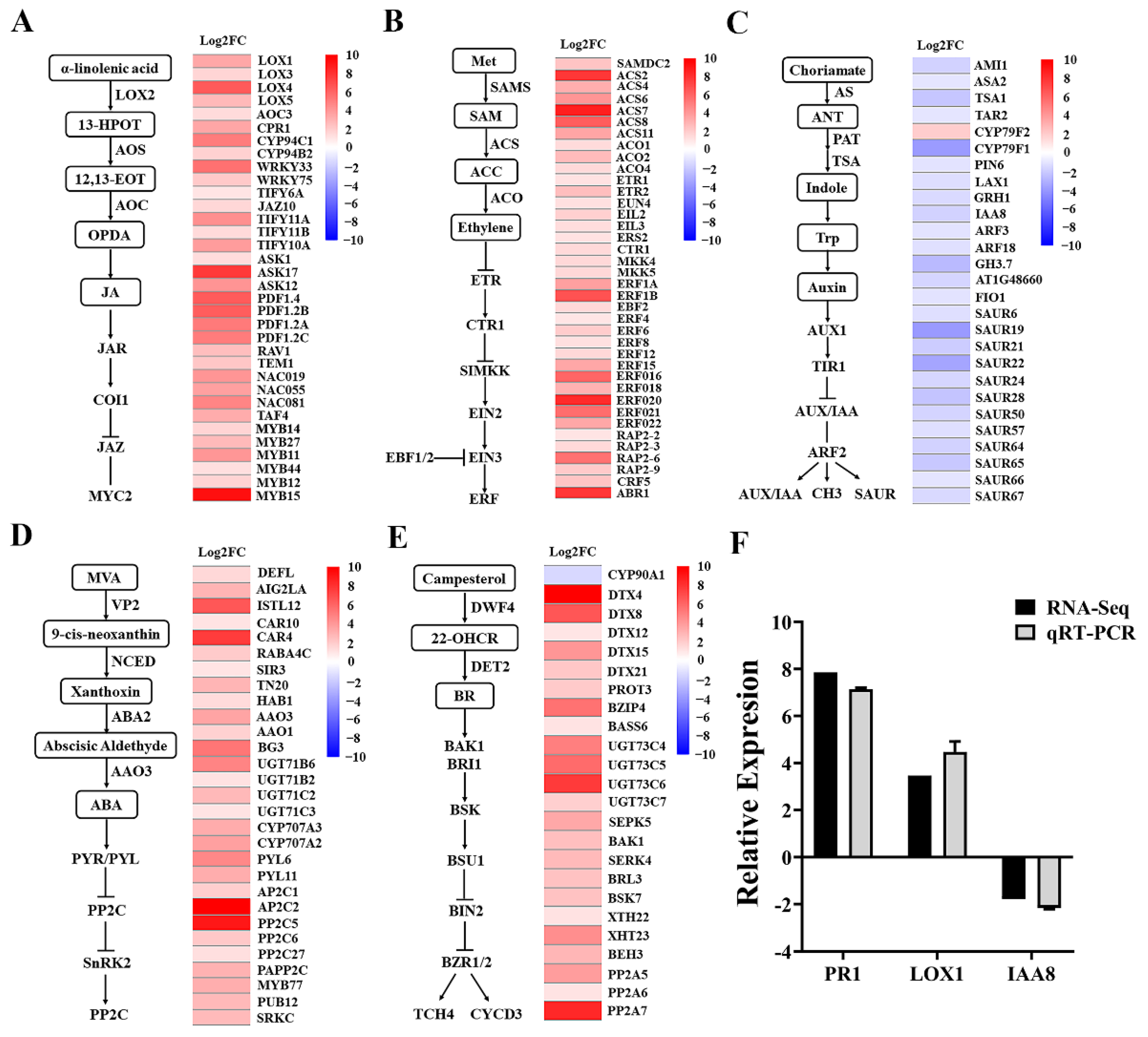Metabolites from Bacillus subtilis J-15 Affect Seedling Growth of Arabidopsis thaliana and Cotton Plants
Abstract
:1. Introduction
2. Results
2.1. Effect of J-15-Ms on Arabidopsis Growth
2.2. Effect of J-15-Ms on Cotton Growth
2.3. LC-MS Identification and Taxonomic Analysis of J-15-Ms
2.4. Effect of Mycosubtilin on Arabidopsis Growth
2.5. Expression Pattern of the Genes Associated with Growth Regulatory Mechanisms of Mycosubtilin in Arabidopsis
3. Discussion
4. Materials and Methods
4.1. Strain Activation and Extraction of Metabolites
4.2. Cultivation and Treatment of Arabidopsis Seedlings
4.3. Cultivation and Treatment of Cotton Seedlings
4.4. Growth Indicators in Arabidopsis Treated with J-15-Ms
4.5. Growth Indicators in Arabidopsis Treated with J-15-Ms
4.6. Full-Spectrum LC-MS Detection of J-15-Ms
4.7. Growth Indicators in Arabidopsis Treated with Mycosubtilin
4.8. Gene Expression of the Hormone Signaling Pathways of Arabidopsis Treated with Mycosubtilin
4.9. Statistics
5. Conclusions
Supplementary Materials
Author Contributions
Funding
Institutional Review Board Statement
Informed Consent Statement
Data Availability Statement
Conflicts of Interest
References
- Trivedi, P.; Leach, J.E.; Tringe, S.G.; Sa, T.; Singh, B.K. Plant–microbiome interactions: From community assembly to plant health. Nat. Rev. Microbiol. 2020, 18, 607–621. [Google Scholar] [CrossRef]
- Kloepper, J.W.; Leong, J.; Teintze, M.; Schroth, M.N. Enhanced plant growth by siderophores produced by plant growth promoting rhizobacteria. Nature 1980, 268, 885–886. [Google Scholar] [CrossRef]
- Bhattacharyya, P.N.; Jha, D.K. Plant growth-promoting rhizobacteria (PGPR): Emergence in agriculture. World J. Microbiol. Biotechnol. 2012, 28, 1327–1350. [Google Scholar] [CrossRef] [PubMed]
- Wang, H.; Liu, R.J.; You, M.P.; Barbetti, M.J. Pathogen Biocontrol Using Plant Growth-Promoting Bacteria (PGPR): Role of Bacterial Diversity. Microorganisms 2021, 9, 1988. [Google Scholar] [CrossRef] [PubMed]
- Gray, E.J.; Smith, D.L. Intracellular and extracellular PGPR: Commonalities and distinctions in the plant-bacterium signalling processes. Soil Biol. Biochem. 2005, 37, 395–412. [Google Scholar] [CrossRef]
- Olenska, E.; Malek, W.; Wojcik, I.; Swiecicka, I.; Thijs, S.; Vangronsveld, J. Beneficial features of plant growth-promoting rhizobacteria for improving plant growth and health in challenging conditions: A methodical review. Sci. Total Environ. 2020, 743, 140682. [Google Scholar] [CrossRef]
- Van Oosten, M.J.; Di Stasio, E.; Cirillo, V.; Silletti, S.; Ventorino, V. Root inoculation with Azotobacter chroococcum 76A enhances tomato plants adaptation to salt stress under low N conditions. BMC Plant Biol. 2018, 18, 205. [Google Scholar] [CrossRef] [Green Version]
- Woo, O.G.; Kim, H.; Kim, J.S.; Keum, H.L.; Lee, K.C. Bacillus subtilis strain GOT9 confers enhanced tolerance to drought and salt stresses in Arabidopsis thaliana and Brassica campestris. Plant Physiol. Biochem. 2020, 148, 359–367. [Google Scholar] [CrossRef]
- Benidire, L.; Madline, A.; Pereira, S.I.A.; Castro, P.M.L.; Boularbah, A. Synergistic effect of organo-mineral amendments and plant growth-promoting rhizobacteria (PGPR) on the establishment of vegetation cover and amelioration of mine tailings. Chemosphere 2020, 262, 127803. [Google Scholar] [CrossRef]
- Peng, J.I.; Ma, J.; Wei, X.Y.; Zhang, C.M.; Jia, N.; Wang, X.; Wang, E.T.; Hu, D.; Wang, Z.W. Accumulation of beneficial bacteria in the rhizosphere of maize (Zea mays L.) grown in a saline soil in responding to a consortium of plant growth promoting rhizobacteria. Ann. Microbiol. 2021, 71, 40. [Google Scholar] [CrossRef]
- Sabaté, D.C.; Brandan, C.P.; Petroselli, G.; Balsells, R.E.; Audisio, M.C. Decrease in the incidence of charcoal root rot in common bean (Phaseolus vulgaris L.) by Bacillus amyloliquefaciens B14, a strain with PGPR properties. Biol. Control 2017, 113, 1–8. [Google Scholar] [CrossRef]
- Pérez-Rodriguez, M.M.; Piccoli, P.; Anzuay, M.S.; Baraldi, R.; Neri, L. Native bacteria isolated from roots and rhizosphere of Solanum lycopersicum L. increase tomato seedling growth under a reduced fertilization regime. Sci. Rep. 2020, 10, 15642. [Google Scholar] [CrossRef]
- Kumar, A.; Prakash, A.; Johri, B.N. Bacillus as PGPR in Crop Ecosystem. In Bacteria in Agrobiology: Crop Ecosystems; Springer: Berlin/Heidelberg, Germany, 2011; pp. 37–59. [Google Scholar]
- Backer, R.; Rokem, J.S.; Ilangumaran, G.; Lamont, J.; Praslickova, D. Plant Growth-Promoting Rhizobacteria: Context, Mechanisms of Action, and Roadmap to Commercialization of Biostimulants for Sustainable Agriculture. Front. Plant Sci. 2018, 9, 1473. [Google Scholar] [CrossRef] [Green Version]
- Ambawade, M.S.; Pathade, G.R. Production of gibberellic acid by Bacillus siamensis BE 76 isolated from banana plant (Musa spp.). Int. J. Sci. Res. 2015, 4, 394–398. [Google Scholar]
- Patten, C.L.; Glick, B.R. Bacterial biosynthesis of indole-3-acetic acid. Can. J. Microbiol. 1996, 42, 207–220. [Google Scholar] [CrossRef] [PubMed]
- Asari, S.; Tarkowská, D.; Rolčík, J.; Novák, O.; Palmero, D.V. Analysis of plant growth-promoting properties of Bacillus amyloliquefaciens UCMB5113 using Arabidopsis thaliana as host plant. Planta 2016, 245, 15–30. [Google Scholar] [CrossRef] [PubMed] [Green Version]
- Sheng, X.F.; He, L.Y.; Wang, Q.Y.; Ye, H.S.; Jiang, C.Y. Effects of inoculation of biosurfactant-producing Bacillus sp. J119 on plant growth and cadmium uptake in a cadmium-amended soil. J. Hazard. Mater. 2008, 155, 17–22. [Google Scholar] [CrossRef]
- Vibhuti, M.; Kumar, A.; Sheoran, N.; Nadakkakath, A.V.; Eapen, S.J. Molecular Basis of Endophytic Bacillus megaterium-induced Growth Promotion in Arabidopsis thaliana: Revelation by Microarray-based Gene Expression Analysis. J. Plant Growth Reg. 2017, 36, 118–130. [Google Scholar] [CrossRef]
- Lee, S.; Trịnh, C.S.; Lee, W.J.; Jeong, C.Y.; Truong, H.A. Bacillus subtilis strain L1 promotes nitrate reductase activity in Arabidopsis and elicits enhanced growth performance in Arabidopsis, lettuce, and wheat. J. Plant Res. 2020, 133, 231–244. [Google Scholar] [CrossRef]
- Hasan, N.; Khan, I.U.; Farzand, A.; Heng, Z.; Moosa, A. Bacillus altitudinis HNH7 and Bacillus velezensis HNH9 promote plant growth through upregulation of growth-promoting genes in upland cotton. J. Appl. Microbiol. 2022, 132, 3812–3824. [Google Scholar] [CrossRef]
- Deng, C.; Zhang, N.; Liang, X.L.; Huang, T.; Li, B.X. Bacillus aryabhattai LAD impacts rhizosphere bacterial community structure and promotes maize plant growth. J. Sci. Food Agric. 2022, 102, 6650–6657. [Google Scholar] [CrossRef] [PubMed]
- Franco-Sierra, N.D.; Posada, L.F.; Santa-María, G.; Romero-Tabarez, M. Bacillus subtilis EA-CB0575 genome reveals clues for plant growth promotion and potential for sustainable agriculture. Funct. Integr. Genom. 2020, 20, 575–589. [Google Scholar] [CrossRef]
- Li, F.; Tang, M.; Tang, X.X.; Sun, W.; Gong, J.Y.; Yi, Y. Bacillus subtilis—Arabidopsis thaliana: A model interaction system for studying the role of volatile organic compounds in the interchange between plants and bacteria. Botany 2019, 97, 661–669. [Google Scholar] [CrossRef]
- Xie, X.T.; Zhang, H.M.; Paré, P.W. Sustained growth promotion in Arabidopsis with long-term exposure to the beneficial soil bacterium Bacillus subtilis (GB03). Plant Signal. Behav. 2009, 4, 948–953. [Google Scholar] [CrossRef] [PubMed] [Green Version]
- Gowtham, H.G.; Brijesh, S.S.; Murali, M.; Shilpa, N.; Melvin, P.; Mohammed, A.; Amruthesh, K.N.; Niranjana, S.R. Induction of drought tolerance in tomato upon the application of ACC deaminase producing plant growth promoting rhizobacterium Bacillus subtilis Rhizo SF 48. Microbiol. Res. 2020, 234, 126422. [Google Scholar]
- Zhang, H.M.; Murzello, C.; Sun, Y.; Kim, M.S.; Xie, X.T. Choline and osmotic-stress tolerance induced in Arabidopsis by the soil microbe Bacillus subtilis (GB03). Mol. Plant Microbe Interact. 2010, 23, 1097–1104. [Google Scholar] [CrossRef] [PubMed] [Green Version]
- Jiang, C.H.; Liao, M.J.; Wang, H.K.; Zheng, M.Z.; Xu, J.J.; Guo, J.H. Bacillus velezensis, a potential and efficient biocontrol agent in control of pepper gray mold caused by Botrytis cinerea. Biol. Control 2018, 126, 147–157. [Google Scholar] [CrossRef]
- Chandrasekaran, M.; Paramasivan, M.; Chun, S.C. Bacillus subtilis CBR05 induces Vitamin B6 biosynthesis in tomato through the de novo pathway in contributing disease resistance against Xanthomonas campestris pv. vesicatoria. Sci. Rep. 2019, 9, 6495. [Google Scholar] [CrossRef] [Green Version]
- Deleu, M.; Razafindralambo, H.L.; Popineau, Y.; Jacques, P.; Thonart, P.; Paquot, M. Interfacial and emulsifying properties of lipopeptides from Bacillus subtilis. Colloids Surf. A Physicochem. Eng. Asp. 1999, 152, 3–10. [Google Scholar] [CrossRef]
- Arrebola, E.; Jacobs, R.; Korsten, L. Iturin A is the principal inhibitor in the biocontrol activity of Bacillus amyloliquefaciens PPCB004 against postharvest fungal pathogens. J. Appl. Microbiol. 2010, 108, 386–395. [Google Scholar] [CrossRef]
- Deleu, M.; Paquot, M.; Nylander, T. Effect of fengycin, a lipopeptide produced by Bacillus subtilis, on model biomembranes. Biophys. J. 2008, 94, 2667–2679. [Google Scholar] [CrossRef] [PubMed] [Green Version]
- Ongena, M.; Jourdan, E.; Adam, A.; Paquot, M.; Brans, A. Surfactin and fengycin lipopeptides of Bacillus subtilis as elicitors of induced systemic resistance in plants. Environ. Microbiol. 2007, 9, 1084–1090. [Google Scholar] [CrossRef] [PubMed]
- Jayakumar, A.; Krishna, A.; Mohan, M.; Nair, I.C.; Radhakrishnan, E.K. Plant Growth Enhancement, Disease Resistance, and Elemental Modulatory Effects of Plant Probiotic Endophytic Bacillus sp. Fcl1. Probiotics Antimicrob. Proteins 2019, 11, 526–534. [Google Scholar] [CrossRef]
- Bais, H.P.; Fall, R.; Vivanco, J.M. Biocontrol of Bacillus subtilis against infection of Arabidopsis roots by Pseudomonas syringae is facilitated by biofilm formation and surfactin production. Plant Physiol. 2004, 134, 307–319. [Google Scholar] [CrossRef] [PubMed] [Green Version]
- Gond, S.K.; Bergen, M.S.; Torres, M.S.; White, J.F. Endophytic Bacillus spp. produce antifungal lipopeptides and induce host defence gene expression in maize. Microbiol. Res. 2014, 172, 79–87. [Google Scholar] [CrossRef] [PubMed]
- Tunsagool, P.; Jutidamrongphan, W.; Phaonakrop, N.; Jaresitthikunchai, J.; Roytrakul, S. Insights into stress responses in mandarins triggered by Bacillus subtilis cyclic lipopeptides and exogenous plant hormones upon Penicillium digitatum infection. Plant Cell Rep. 2019, 38, 559–575. [Google Scholar] [CrossRef] [PubMed]
- Ongena, M.; Jacques, P.; Touré, Y.; Destain, J.; Jabrane, A. Involvement of fengycin-type lipopeptides in the multifaceted biocontrol potential of Bacillus subtilis. Appl. Microbiol. Biotechnol. 2005, 69, 29–38. [Google Scholar] [CrossRef]
- Farace, G.; Fernandez, O.; Jacquens, L.; Coutte, F.; Krier, F. Cyclic lipopeptides from Bacillus subtilis activate distinct patterns of defence responses in grapevine. Mol. Plant Pathol. 2015, 16, 177–187. [Google Scholar] [CrossRef]
- Wu, M.J.; Yang, Q.L.; Li, Y.H.; Ge, F.W.; Zhao, Q.Q.; Yuan, L.L.; Ning, H.C.; Chen, Z.Y.; Li, J.Y.; Zhao, H.X. Effect of BS-Z15 Metabolites on Cotton Verticillium wilt Prevention and Cotton Growth. Mol. Plant Breed. 2019, 17, 8237–8244. [Google Scholar]
- Zhao, Q.Q.; Wu, M.J.; Dong, Y.Y.; Wang, Q.Y.; Lin, R.R.; Zhao, H.P.; Zhao, H.X. Antifungal Activity of BS-Z15 Metabolites and Its Safety in Mice. Nat. Prod. Res. Dev. 2018, 30, 1608–1613, 1620. [Google Scholar]
- Abuduaini, X.; Nuer, H.; Zhao, Q.Q.; Li, S.T.; Liu, J.Q.; Zhao, H.P.; Zhao, H.X. Effects of Bacillus subtilis J-15 secondary metabolites against Verticillium dahliae on diversity of soil fungi. Microbiol. China 2021, 48, 1997–2007. [Google Scholar]
- Chen, Z.Y.; Abuduaini, X.; Mamat, N.; Yang, Q.L. Genome sequencing and functional annotation of Bacillus sp. strain BS-Z15 isolated from cotton rhizosphere soil having antagonistic activity against Verticillium dahliae. Arch. Microbiol. 2021, 203, 1565–1575. [Google Scholar] [CrossRef] [PubMed]
- Lin, R.R.; Zhang, Q.; Yin, L.; Zhang, Y.W.; Yang, Q.L. Isolation and characterization of a mycosubtilin homologue antagonizing Verticillium dahliae produced by Bacillus subtilis strain Z15. PLoS ONE 2022, 17, e0269861. [Google Scholar] [CrossRef] [PubMed]
- Yuan, Y.D.; Zu, M.T.; Sun, L.P.; Zuo, J.J.; Tao, J. Isolation and Screening of 1-aminocyclopropane-1-carboxylic acid (ACC) deaminase producing PGPR from Paeonia lactiflora rhizosphere and enhancement of plant growth. Sci. Hortic. 2022, 297, 110956. [Google Scholar] [CrossRef]
- Han, L.Z.; Zhang, H.; Xu, Y.; Li, Y.; Zhou, J. Biological characteristics and salt-tolerant plant growth-promoting effects of an ACC deaminase-producing Burkholderia pyrrocinia strain isolated from the tea rhizosphere. Archives of microbiology. Arch. Microbiol. 2021, 203, 2279–2290. [Google Scholar] [CrossRef]
- He, A.; Niu, S.Q.; Yang, D.; Ren, W.; Zhao, L.Y. Two PGPR strains from the rhizosphere of Haloxylon ammodendron promoted growth and enhanced drought tolerance of ryegrass. Plant Physiol. Biochem. 2021, 161, 74–85. [Google Scholar] [CrossRef] [PubMed]
- Trinh, C.S.; Jeong, C.Y.; Lee, W.J.; Truong, H.A.; Chung, N. Paenibacillus pabuli strain P7S promotes plant growth and induces anthocyanin accumulation in Arabidopsis thaliana. Plant Physiol. Biochem. 2018, 129, 264–272. [Google Scholar] [CrossRef] [PubMed]
- Panda, S.; Jozwiak, A.; Sonawane, P.D.; Szymanski, J.; Kazachkova, A. Steroidal alkaloids defence metabolism and plant growth are modulated by the joint action of gibberellin and jasmonate signalling. New Phytol. 2022, 233, 1220–1237. [Google Scholar] [CrossRef]
- Nakagawa, A.; Sakamoto, S.; Takahashi, M.; Morikawa, H.; Sakamoto, A. The RNAi-mediated silencing of xanthine dehydrogenase impairs growth and fertility and accelerates leaf senescence in transgenic Arabidopsis plants. Plant Cell Physiol. 2007, 48, 1484–1495. [Google Scholar] [CrossRef]
- Wang, Y.C.; Qian, W.J.; Li, N.N.; Hao, X.Y.; Wang, L.; Xiao, B.; Wang, X.C.; Yang, Y.G. Metabolic Changes of Caffeine in Tea Plant (Camellia sinensis (L.) O. Kuntze) as Defense Response to Colletotrichum fructicola. J. Agric. Food Chem. 2016, 64, 6685–6693. [Google Scholar] [CrossRef]
- Puckhaber, L.S.; Dowd, M.K.; Stipanovic, R.D.; Howell, C.R. Toxicity of (+)- and (-)-gossypol to the plant pathogen, Rhizoctonia solani. J. Agric. Food Chem. 2002, 50, 7017–7021. [Google Scholar] [CrossRef] [PubMed]
- Zaynab, M.; Sharif, Y.; Abbas, S.; Afzal, M.; Qasim, M. Saponin toxicity as key player in plant defense against pathogens. Toxicon 2021, 193, 21–27. [Google Scholar] [CrossRef] [PubMed]
- Ta, C.A.K.; Guerrero-Analco, J.A.; Roberts, E.; Liu, R.; Mogg, C.D.; Saleem, A. Antifungal Saponins from the Maya Medicinal Plant Cestrum schlechtendahlii G. Don (Solanaceae). Phytother. Res. 2016, 30, 439–446. [Google Scholar] [CrossRef] [PubMed]
- Simmler, C.; Pauli, G.F.; Chen, S.N. Phytochemistry and biological properties of glabridin. Fitoterapia 2013, 90, 160–184. [Google Scholar] [CrossRef] [PubMed] [Green Version]
- Lin, J.Y.; He, Q.; Wang, B.; Yang, Y.h.; Yang, C.P.; Chen, H.B.; Yue, G.Z. Synthesis and Antifungal Activities of Isoflavenes Derivatives. Chin. J. Synth. Chem. 2022, 1–10. [Google Scholar]
- Lugtenberg, B.; Kamilova, F. Plant-growth-promoting rhizobacteria. Annu. Rev. Microbiol. 2009, 63, 541–556. [Google Scholar] [CrossRef]
- Bhojiya, A.A.; Joshi, H.; Upadhyay, S.K.; Srivastava, A.K.; Pathak, V.V.; Pandey, V.C.; Jain, D. Screening and Optimization of Zinc Removal Potential in Pseudomonas aeruginosa-HMR1 and its Plant Growth-Promoting Attributes. Bull. Environ. Contam. Toxicol. 2021, 108, 468–477. [Google Scholar] [CrossRef]
- Zubair, M.; Hanif, A.; Farzand, A.; Sheikh, T.M.M.; Khan, A.R.; Suleman, M.; Ayaz, M.; Gao, X.W. Genetic screening and expression analysis of psychrophilic Bacillus spp. reveal their potential to alleviate cold stress and modulate phytohormones in wheat. Microorganisms 2019, 7, 337. [Google Scholar] [CrossRef] [Green Version]
- Vaishnav, A.; Choudhary, D.K. Regulation of drought-responsive gene expression in Glycine max L. Merrill is mediated through Pseudomonas simiae strain AU. J. Plant Growth Regul. 2019, 38, 333–342. [Google Scholar] [CrossRef]
- Vejan, P.; Abdullah, R.; Abdullah, R.; Khadiran, T.; Ismail, S. Role of Plant Growth Promoting Rhizobacteria in Agricultural Sustainability—A Review. Molecules 2016, 21, 573. [Google Scholar] [CrossRef] [Green Version]
- De Smet, I.; Zhang, H.M.; Inzé, D.; Beeckman, T. A novel role for abscisic acid emerges from underground. Trends Plant Sci. 2006, 11, 434–439. [Google Scholar] [CrossRef] [PubMed]
- Davies, P.J. Plant Hormones: Physiology, Biochemistry and Molecular Biology; Kluwer Academic: Boston, MA, USA, 1995. [Google Scholar]
- Malfanova, N.; Kamilova, F.; Validov, S.; Shcherbakov, A.; Chebotar, V.; Tikhonovich, I.; Lugtenberg, B. Characterization of Bacillus subtilis HC8, a novel plant-beneficial endophytic strain from giant hogweed. Microb. Biotechnol. 2011, 4, 523–532. [Google Scholar] [CrossRef] [PubMed] [Green Version]
- Sun, J.; Xu, Y.; Ye, S.; Jiang, H.; Chen, Q.; Liu, F.; Zhou, W.; Chen, R.; Li, X.; Tietz, O.; et al. Arabidopsis ASA1 is important for jasmonate-mediated regulation of auxin biosynthesis and transport during lateral root formation. Plant Cell 2009, 21, 1495–1511. [Google Scholar] [CrossRef] [PubMed] [Green Version]
- Han, X.; Zhang, M.; Yang, M.; Hu, Y. Arabidopsis JAZ Proteins interact with and suppress RHD6 transcription factor to regulate jasmonate-stimulated root hair development. Plant Cell 2020, 32, 1049–1062. [Google Scholar] [CrossRef] [PubMed]
- Růžička, K.; Ljung, K.; Vanneste, S.; Podhorská, R.; Beeckman, T.; Friml, J.; Benková, E. Ethylene regulates root growth through effects on auxin biosynthesi and transport-dependent auxin distribution. Plant Cell 2007, 19, 2197–2212. [Google Scholar] [CrossRef] [Green Version]
- Rzewuski, G.; Sauter, M. Ethylene biosynthesis and signaling in rice. Plant Sci. 2008, 175, 32–42. [Google Scholar] [CrossRef]
- Marta, D.B.; Stefan, K. Context, specificity, and self-organization in auxin response. Cold Spring Harb. Perspect. Biol. 2011, 3, a001578. [Google Scholar]
- Woodward, A.W.; Bonnie, B. Auxin: Regulation, action, and interaction. Ann. Bot. 2005, 95, 707–735. [Google Scholar] [CrossRef] [Green Version]
- Khan, S.; Stone, J.M. Arabidopsis thaliana GH3.9 influences primary root growth. Planta 2007, 226, 21–34. [Google Scholar] [CrossRef] [Green Version]
- Mishra, B.S.; Singh, M.; Aggrawal, P.; Laxmi, A. Glucose and auxin signaling interaction in controlling Arabidopsis thaliana seedlings root growth and development. PLoS ONE 2009, 4, e4502. [Google Scholar] [CrossRef]
- Yamauchi, T.; Tanaka, A.; Inahashi, H.; Nishizawa, N.K.; Tsutsumi, N.; Inukai, Y.; Nakazono, M. Fine control of aerenchyma and lateral root development through AUX/IAA- and ARF-dependent auxin signaling. Proc. Natl. Acad. Sci. USA 2019, 116, 20770–20775. [Google Scholar] [CrossRef] [PubMed] [Green Version]
- Cui, P.; Liu, H.B.; Ruan, S.L.; Ali, B.; Gill, R.A.; Ma, H.S.; Zheng, Z.F.; Zhou, W.J. A zinc finger protein, interacted with cyclophilin, affects root development via IAA pathway in rice. J. Integr. Plant Biol. 2017, 59, 496–505. [Google Scholar] [CrossRef] [PubMed]
- Spence, C.; Bais, H. Role of plant growth regulators as chemical signals in plant-microbe interactions: A double edged sword. Curr. Opin. Plant Biol. 2015, 27, 52–58. [Google Scholar] [CrossRef]
- Xing, L.; Zhao, Y.; Gao, J.H.; Xiang, C.B.; Zhu, J.K. The ABA receptor PYL9 together with PYL8 plays an important role in regulating lateral root growth. Sci. Rep. 2016, 6, 27177. [Google Scholar] [CrossRef]
- Zhao, Y.; Xing, L.; Wang, X.G.; Hou, Y.J.; Gao, G.H.; Wang, P.C.; Duan, C.G.; Zhu, X.H.; Zhu, J.K. The ABA receptor PYL8 promotes lateral root growth by enhancing MYB77-dependent transcription of auxin-responsive genes. Sci. Signal. 2014, 7, ra53. [Google Scholar] [CrossRef] [Green Version]
- Belkhadir, Y.; Jaillais, Y. The molecular circuitry of brassinosteroid signaling. New Phytol. 2015, 206, 522–540. [Google Scholar] [CrossRef] [PubMed]
- Wei, Z.Y.; Li, J. Brassinosteroids Regulate Root Growth, Development, and Symbiosis. Mol. Plant. 2015, 9, 86–100. [Google Scholar] [CrossRef]
- Zhang, C.; He, M.L.; Wang, S.L.; Chu, L.Y.; Wang, C.; Yang, N.M.; Ding, G.D.; Cai, H.M.; Shi, L.; Xu, F.S. Boron deficiency-induced root growth inhibition is mediated by brassinosteroid signalling regulation in Arabidopsis. Plant J. 2021, 107, 564–578. [Google Scholar] [CrossRef]
- Li, J.; Wen, J.Q.; Lease, K.A.; Doke, J.T.; Tax, F.E. BAK1, an Arabidopsis LRR receptor-like protein kinase, interacts with BRI1 and modulates brassinosteroid signaling. Cell 2002, 110, 213–222. [Google Scholar] [CrossRef] [Green Version]
- Li, M.X.; Zhu, Y.C.; Li, S.S.; Zhang, W.; Yin, C.X.; Lin, Y.J. Regulation of Phytohormones on the Growth and Development of Plant Root Hair. Front. Plant Sci. 2022, 13, 865302. [Google Scholar] [CrossRef]
- Zhao, J.J.; Zeng, W.J.; Li, Y.H.; Ge, F.W.; Du, Y.; Yuan, L.L.; Zhao, Q.Q. Isolation and identification of antagonistic Bacillus spp. Against Verticillium dahliae: The antibacterial properties of two strains. J. Beijing Norm. Univ. 2017, 53, 294–300. [Google Scholar]






| Metabolite | m/z | Mode | Formula | Peak Area |
|---|---|---|---|---|
| Xanthine | 151.0249 | neg | C5H4N4O2 | 465,374.5 |
| Angularine | 352.1755 | pos | C18H25NO6 | 454,052.7 |
| Ecgonine methyl ester | 241.1547 | pos | C10H17NO3 | 417,993.9 |
| Fagomine | 192.0618 | pos | C6H13NO3 | 345,944.4 |
| Vincristine | 861.3502 | neg | C46H56N4O10 | 238,339 |
| Caffeine | 195.0876 | pos | C8H10N4O2 | 200,524.5 |
| Cardiopetalidine | 364.2455 | pos | C21H33NO4 | 195,000.2 |
| Phenyllactic acid | 165.0545 | neg | C9H10O3 | 185,594.5 |
| Nicotyrine | 159.0916 | pos | C10H10N2 | 126,128.4 |
| Europine | 330.1915 | pos | C16H27NO6 | 106,925.8 |
| 6-Acetylmorphine | 699.2957 | neg | C19H21NO4 | 102,800.9 |
| Petasitenine | 364.1755 | pos | C19H27NO7 | 917,93.65 |
| Monocrotaline | 326.1601 | pos | C16H23NO6 | 69,254.51 |
| Otonecine | 186.1125 | pos | C9H15NO3 | 68,611.49 |
| Hypoxanthine | 137.0457 | pos | C5H4N4O | 60,381.4 |
| Metabolite | m/z | Mode | Formula | Peak Area |
|---|---|---|---|---|
| Gossypol | 519.2048 | pos | C30H30O8 | 649,034 |
| Glaucarubin | 495.2212 | neg | C25H36O10 | 112,114.8 |
| Withanolide | 484.2761 | pos | C28H38O6 | 119,294.7 |
| Agavoside A | 627.3294 | neg | C33H52O9 | 233,633.7 |
| Protodioscin | 1029.526 | neg | C51H84O22 | 3,087,680 |
| Musennin | 1031.541 | pos | C51H82O21 | 2,271,846 |
| Soyasaponin A1 | 633.2946 | neg | C59H96O29 | 70,810.22 |
| Soyasaponin I | 941.5121 | neg | C48H78O18 | 2,321,121 |
| (2R,6S,7S,10Z)-beta-Santala-3(15),10-dien-12-ol | 284.1968 | pos | C15H24O | 33,043.89 |
| (+)-(S)-Carvone | 195.1016 | neg | C10H14O | 29,834.57 |
| Convalloside | 735.3313 | pos | C35H52O15 | 4,774,323 |
| Metabolite | m/z | Mode | Formula | Peak Area |
|---|---|---|---|---|
| Mulberrofuran A | 434.2291 | pos | C25H28O4 | 32,728.46 |
| Genistein | 271.06 | pos | C15H10O5 | 13,176.96 |
| Prenyl glucoside | 293.1241 | neg | C11H20O6 | 120,163.7 |
| Daidzein | 255.0652 | pos | C15H10O4 | 67,927.36 |
| (R)-Glabridin | 647.2687 | neg | C20H20O4 | 76,256.28 |
| Glycitein | 285.0757 | pos | C16H12O5 | 28,548.9 |
| Dihydrokaempferol | 269.0456 | neg | C15H12O6 | 13,101.75 |
| Metabolite | m/z | Mode | Formula | Peak Area |
|---|---|---|---|---|
| Indole | 118.0653 | pos | C8H7N | 540,110.20 |
| 3-Methyloxindole | 148.0756 | pos | C9H9NO | 192,913.81 |
| 3-Methyleneoxindole | 146.0599 | pos | C9H7NO | 115,995.00 |
| Indole-3-carboxaldehyde | 146.0599 | pos | C9H7NO | 96,755.36 |
| Indoleacetaldehyde | 160.0756 | pos | C10H9NO | 83,635.57 |
| 5-Hydroxyindoleacetylglycine | 213.0659 | pos | C12H12N2O4 | 45,844.55 |
| 3-Methylindole | 176.0706 | neg | C9H9N | 37,102.86 |
| 1H-Indole-3-carboxaldehyde | 144.0443 | neg | C9H7NO | 31,995.86 |
| Indole-3-carboxylic acid | 144.0444 | pos | C9H7NO2 | 31,241.96 |
| Indolelactic acid | 204.0659 | neg | C11H11NO3 | 25,155.98 |
| 3-Methyldioxyindole | 144.0441 | neg | C9H9NO2 | 23,865.93 |
| 3-Indoleacetic Acid | 174.055 | neg | C10H9NO2 | 14,909.82 |
| 5-Hydroxyindoleacetic acid | 190.0501 | neg | C10H9NO3 | 14,043.72 |
| Abscisic acid | 229.1221 | pos | C15H20O4 | 10,233.48 |
| Indole-3-acetaldehyde | 201.1021 | pos | C10H9NO | 9261.27 |
| 5,6-Dihydroxyindole | 194.0464 | neg | C8H7NO2 | 2551.33 |
| Jasmonic acid | 191.1068 | neg | C12H18O3 | 2035.92 |
Publisher’s Note: MDPI stays neutral with regard to jurisdictional claims in published maps and institutional affiliations. |
© 2022 by the authors. Licensee MDPI, Basel, Switzerland. This article is an open access article distributed under the terms and conditions of the Creative Commons Attribution (CC BY) license (https://creativecommons.org/licenses/by/4.0/).
Share and Cite
Zhang, H.; Yang, Q.; Zhao, J.; Chen, J.; Wang, S.; Ma, M.; Liu, H.; Zhang, Q.; Zhao, H.; Zhou, D.; et al. Metabolites from Bacillus subtilis J-15 Affect Seedling Growth of Arabidopsis thaliana and Cotton Plants. Plants 2022, 11, 3205. https://doi.org/10.3390/plants11233205
Zhang H, Yang Q, Zhao J, Chen J, Wang S, Ma M, Liu H, Zhang Q, Zhao H, Zhou D, et al. Metabolites from Bacillus subtilis J-15 Affect Seedling Growth of Arabidopsis thaliana and Cotton Plants. Plants. 2022; 11(23):3205. https://doi.org/10.3390/plants11233205
Chicago/Turabian StyleZhang, Hui, Qilin Yang, Jingjing Zhao, Jiayi Chen, Shiqi Wang, Mingyue Ma, Huan Liu, Qi Zhang, Heping Zhao, Dongyuan Zhou, and et al. 2022. "Metabolites from Bacillus subtilis J-15 Affect Seedling Growth of Arabidopsis thaliana and Cotton Plants" Plants 11, no. 23: 3205. https://doi.org/10.3390/plants11233205





